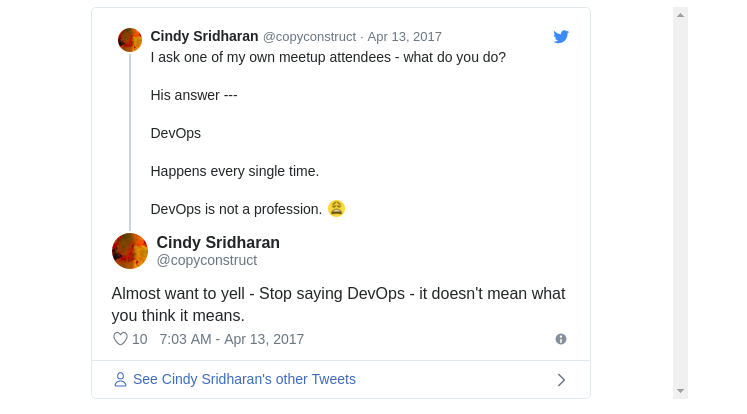DevOps has revolutionized the modern IT world by bringing developers and operations teams to work in close coordination than ever. This alliance has taken the development industry to a whole new extent by breaking down the traditional barriers. Shorter development times with less friction in the software development life cycle has worked wonders saving both time and money of the organization. Sequentially the organizations get an extra edge among their rivals in the highly competitive market.
In an intention to have the best collaboration, it is very much imperative for both the teams to have a common understanding of each other's tasks, workflows, stature, etc, systematically maximizing capability and productivity of the teams. Communication is the key to the former mentioned. Getting the communication culture right is crucial for a DevOps environment. Establishing a clear and precise communication protocol is one of the ways to empower the Dev and Ops teams.
What is DevOps?

DevOps, blend of ‘development’ and ‘operations’, is defined as the set of practices wherein the software development and the operations teams work alongside straightening the software build, test, and release procedure intensifying accountability and speed.
Some say DevOps is the successor of agile software development, which emerged from the growing need to pace up with the software development process streamlining the agile methods. This works as a trust booster enabling the proper management of tasks ( resolving critical issues with ease, rapid software releases, no security compromises ) for the organizations.

DevOps articulates three major essentials, namely, Flow, streamlining the efficient distribution of work in an IT infrastructure from development to operations to customers. Feedback, paced and continuous ‘phased’ feedback from right to left during the complete information and technology operations. Consistent Learning & Experimentation, a procedure to streamline systematic scientific and organizational culture improvement facilitating faith in the work environment.
A recurring cycle is formed with the aforementioned principles, accompanying reframing of many different use cases. Smooth sequencing can only be done if the teams involved are having an excellent open communication channel both inside and outside the organization. Early collaboration with persistent communication from stakeholders, teams, and departments is imperative for the success of the looped feedback procedure. All in all, Communication is an Oxygen of the DevOps culture.
Survey: How lack of communication hampers a DevOps work culture
Inadequate communication due to team segregation has been the biggest challenge within the flow of work inside and outside the organization - Rob Vanstone, XebiaLabs Technical Director UK
Bringing DevOps culture inside the organization is quite easy but keeping it intact for smooth workflow is not as easy as it seems. Standups, meetings on a regular basis are good to start but neither they will do any harm nor will do any favors for the organization. That is why it is imperative to have a continuous communication loop for successful interventions on DevOps.
A recent survey on July 2019, by Trend Micro, assisted by a market research firm Vanson Bourne inspected the behavioral patterns and outlook on DevOps. The surveyed mass belonged to distinct DevOps implementation stages merging IT operations, security, application development with their teams for quick and secure development lifecycle.
It included 1,310 IT decision-makers of both enterprises and SME organizations from the world. Near about three-quarters, 74%, of responders' pronounced, integration of developers, IT operations and cybersecurity processes have now become vital for the hassle-free task flow in an organization. Adding further, more than 34% asserted, isolation or silos has made the execution in DevOps culture very much painful.
When talking about the work connection closeness, 89% proclaimed IT operations and software development should work beside each other maintaining a closer contact. While the same was stated for the developers, security, and operations by the 77% respondents.
DevOps is a crucial game and keeping security teams alongside is prime, stated Indi Siriniwasa, VP of Trend Micro Sub - Saharan Africa, quoting an example from an African context. He further added complete discontinuation will lead developers to take a lot more time than normal for the successful application delivery.
Building ‘Solid’ communication within a DevOps culture

As mentioned before, streamlining a continuous communication channel in DevOps lies on three major principles and to straighten the same following tactics needs to be followed.
#1 Communication Tools ‘Way Forward’
A major paradigm shift happened due to the emergence of DevOps culture. This switch has led to the adoption of a lot many progressive communication procedures by the teams working in collaboration. The very first thing that comes in mind to ease out the process for everyone is embracing the tools for powerful DevOps communication.
But first thing first, it should answer the following queries to have a clear understanding of the tools success metric, like,
- Will the tool gel-well in accordance with the customized organization needs?
- Will it scale as per the organization's strength?
- Will it offer a quick and instant support for the critical issues?
- Will it offer cross-platform collaboration?
Keeping the prior mentioned under consideration, the following tools are assumed to be critical catering a constructive DevOps communication.
Instant Messaging
Digital communication is ruling the world. Instant messenger and chat tools have acquired the majority of the market. Being on mobile it is very much easy to have access to the same keeping the working teams on constant communication among each other. Moreover, the customizable integrations will help in the formation of distinct chat rooms as per the work specifications. Slack is one of the most popular messaging application used by numerous organizations. It enhances transparency with frequent data exchange among the busy DevOps team members.
Enhancing Document Collaboration
Centralization of data repository has done no good for the organizations. The reason being, when needed locally, the data needs to be downloaded on the system in order to perform a simple editing task. Once done, the document needs to be uploaded again to make the changes available for others too. Many modern mobile applications have eased out the process of data collaboration for the organizations, offering reading and editing of the document in one go. In addition to this, writing comments and live edit access for the documents are available for the team members.
Regular Meetings ‘Online’
From the last few years, Videoconferencing and other digital communication mediums have been a major channel facilitating meetings for the team members working locally or across the globe. The modern video calling software and group chat applications have helped to gain more interactive face to face online sessions, easy document sharing, and many other benefits. The best part is it can be done using mobile phones too. Similar to the agile structure, teams in a DevOps culture have to do such meetings on a frequent basis to deliver the best solutions to the customers.
#2 Feedback Loop ‘In effect’
Communication happening in an organization does not need to be worthy. Many times messages sent from a place will not reach its intended receiver, making the communication in-effective. In a rapidly growing DevOps environment, a bold and dynamic approach needs to be followed for the successful communication among the developers, testers, stakeholders to deliver assertive solutions to the end-users.
Precise and well-maintained documentation is imperative for productive DevOps communication. Sequentially, consistent monitoring to have better insight and analytic reports of the systems will bring many favors for the organization. Prometheus with Grafana has been the most cherished tool for effective monitoring.
#3 Prioritization for Productive Team Communication
The major ingredient of the complete DevOps communication process is ensuring feedback is reaching its prospective receiver and the teams. Implementation of the communication channels along with the feedback loops is quite easy but assuring ‘every time response’ is critical. Impromptu feedback to the requests, messages received should be given even if the solution for the same is not available.
Moreover, ranking the issues cropped on a priority basis and taking immediate actions will never make a process to fall behind. A healthy and proactive approach by the communicating teams, stakeholders will help the organization to deliver valuable assets through a DevOps pipeline.
#4 Flowcharts Bringing Transparency
Binding of development and operations teams creates a lot of confusion for both the interacting teams. No one basically understands the basic work procedure of each. With the purpose of establishing the transparency, a ‘single-source’ schematic chart representing everyone’s workflow is created. This will lead to feedback loops amplifications. The diagram thus created will encourage deep understanding among the working teams removing the performance and communication bottlenecks.
Conclusion
Communication, collaboration, and integration are the three main principles of the DevOps culture. In order to adopt a successful DevOps culture, it is very much vital to bring improvement in the feedbacks and communications between the teams and the stakeholders. Having a common ground on the understanding and usage of a communication protocol will empower the employees to make use of the available avenues of communication. Enhancing communication with legitimate time management will eventually maximize the productivity of the organization as a whole.
Subscribe
Related Blogs
Trek n Tech Annual Retreat 2025: A 7-Day Workcation of OSL

OSL family came together for the Trek n Tech Annual Retreat 2025, a 7-day workcation set amidst the serene beauty of…
Exploring Drupal's Single Directory Components: A Game-Changer for Developers

Web development thrives on efficiency and organisation, and Drupal, our favourite CMS, is here to amp that up with its…
7 Quick Steps to Create API Documentation Using Postman

If you work with API , you are likely already familiar with Postman, the beloved REST Client trusted by countless…




